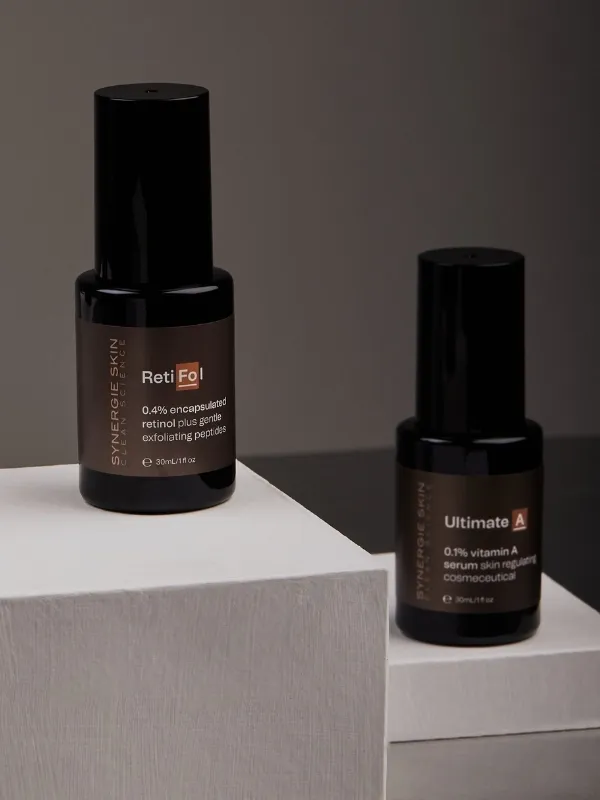Retinol sandwiching has become a trending topic in the skincare community, so I thought I’d shed some light on the matter through a scientific lens.

First off, I’ll say that – as of the time I am writing this – there doesn’t appear to be very much scientific literature supporting the efficacy of ‘retinol sandwiching’. That doesn’t mean it doesn’t work, but I’m just saying that it lacks substantiated evidence for the moment.
What is the retinol sandwich method?
The idea behind this sandwiching technique is an offshoot from the ‘moisture sandwiching’ method, which involves the use of moisturisers to prevent transepidermal water loss whilst maintaining the skin's hydration and luminosity. In the case of retinol sandwiching, the retinol is placed between two layers of moisturiser, with intention to prevent skin irritation and inflammatory ‘hotspots’ - particularly during the initial stage of incorporating retinol into one’s skincare routine.
Retinol has been known to cause some potentially irritating effects, especially in those who are new to its use, are using a dosage that it too high for their skin, or have sensitive skin profiles. The retinol sandwich technique attempts to solve this problem by enabling consumers to create a barrier between the retinol and the skin with moisturisers, which makes it possible to introduce retinol to the skin in a gentle and non-irritating way. It is quite simply, creating a diluted form of the ingredient with adding moisturisers. So the ultimate purpose of this method is to help reduce discomfort and dryness associated with early or high dose retinol use for sensitive skin profiles.
The pervading theory here is that by using this technique, one can gradually introduce more retinol to the skin, helping it to adapt and strengthen so it can eventually tolerate retinol on its own.
How to sandwich retinol?
In short, the retinol sandwiching technique is as follows:
- Cleanse your skin
- Apply a layer of moisturiser to damp skin
- Allow this to dry completely
- Apply your retinol
- After giving retinol time to absorb, finish your skincare routine with a second layer of moisturiser
So is retinol sandwiching effective?
What makes me sceptical of this trend is that this is yet another classic example of mainstream influencers adopting the word 'retinol' in place of 'retinoid'. It implies that the only valid form of vitamin A on the market is ‘retinol’, which of course, isn’t true. And given the current cellular delivery systems of retinol in skincare, I’m not entirely convinced that diluting it with two layers of moisturiser is a scientifically sound practice.
For example, prescription-strength retinoic acid (aka tretinoin) topical lotions (common brand names are Retin-A or StievaA) are far more in need of dilution compared to even raw retinol! Meanwhile, encapsulated retinol in Ultimate A (liposome capsule) and RetiFol (cellulose capsule) uses controlled release and targeted delivery methods that keep the raw retinol active and stable whilst greatly inhibiting its ability to irritate the surface layers of the skin. In the instance that these particular retinol skincare products were part of your routine, diluting them via retinol sandwiching would do very little in the way of minimising irritation, yet would significantly reduce their vitamin A benefits by essentially diluting them with other products. What a waste!
Another aspect of the retinol sandwiching method that concerns me is that the user needs to be highly aware of the compatibility of specific ingredients in their moisturisers. I.e. what you are using as the 'bread' in the sandwich must work well with retinol. Failure to understand these components may result in deactivated retinol or undesirable skin reactions, which makes this method difficult to recommend.
I will say however, that during a ‘retinol purge’, this method may become useful, but there is still plenty you can do to have a gentler retinol experience without the need to sandwich, such as lowering the percentage of the dosage of your vitamin A products. (For more on retinol purging, read our previous FAQ blog all about retinol).
Before retinol sandwiching, check the formula first!
In my view, the intensity of retinol is not an issue that needs to be necessarily addressed with sandwiching – above all, it's the dosage and delivery method of the formula that must first complement the skin type.
Even when it comes to prescription retinoids, most doctors and dermatologists would recommend staggering their use every third or fourth day (sometimes mixing in a moisturiser directly, depending on your skin profile) before working up to daily use over three-to-six months in order to build tolerance; and I would lean towards this simple dosage advice before experimenting with sandwiching.
Ultimately, when it comes to building tolerance to vitamin A skincare, I strongly believe that cosmeceutical users should first empower themselves by gaining a firm understanding of their own skin type before commencing their vitamin A journey. If you use the right skincare products from the outset - based on sound scientific knowledge of your skin profile - then you shouldn’t have any need to blend them with moisturisers.
[Disclaimer: This blog is for informational purposes only and does not substitute professional medical advice. Consult a dermatologist or skincare professional for specific concerns.]





